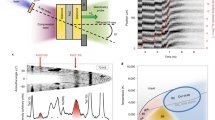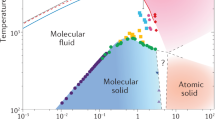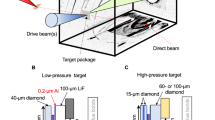Abstract
The recent discovery of thousands of planets outside our Solar System raises fundamental questions about the variety of planetary types and their corresponding interior structures and dynamics. To better understand these objects, there is a strong need to constrain material properties at the extreme pressures found within planetary interiors1,2. Here we used high-powered lasers at the National Ignition Facility to ramp compress iron over nanosecond timescales to 1.4 TPa (14 million atmospheres)—a pressure four times higher than for previous static compression data. A Lagrangian sound-speed analysis was used to determine pressure, density and sound speed along a continuous isentropic compression path. Our peak pressures are comparable to those predicted at the centre of a terrestrial-type exoplanet of three to four Earth masses3, representing the first absolute equation of state measurements for iron at such conditions. These results provide an experiment-based mass–radius relationship for a hypothetical pure iron planet that can be used to evaluate plausible compositional space for large, rocky exoplanets.
This is a preview of subscription content, access via your institution
Access options
Access Nature and 54 other Nature Portfolio journals
Get Nature+, our best-value online-access subscription
$29.99 / 30 days
cancel any time
Subscribe to this journal
Receive 12 digital issues and online access to articles
$119.00 per year
only $9.92 per issue
Buy this article
- Purchase on Springer Link
- Instant access to full article PDF
Prices may be subject to local taxes which are calculated during checkout




Similar content being viewed by others
Change history
24 April 2018
In the version of this Letter originally published, in the Acknowledgements, the surname of M. Herrmann was misspelt as ‘Hermann’. This has now been corrected.
References
Valencia, D., O’Connell, R. J. & Sasselov, D. Internal structure of massive terrestrial planets. Icarus 181, 545–554 (2006).
Swift, D. C. et al. Mass–radius relationships for exoplanets. Astrophys. J. 744, 59 (2012).
Wagner, F. W., Tosi, N., Sohl, F., Rauer, H. & Spohn, T. Rocky super-Earth interiors— Structure and internal dynamics of CoRoT-7b and Kepler-10b. Astron. Astrophys. 541, A103 (2012).
Marcy, G. W. et al. Occurrence and core-envelope structure of 1–4x Earth-size planets around Sun-like stars. Proc. Natl Acad. Sci. USA 111, 12655–12660 (2014).
Santos, N. et al. Constraining planet structure from stellar chemistry: the cases of CoRoT-7, Kepler-10, and Kepler-93. Astron. Astrophys. 580, L13 (2015).
Gillon, M. et al. Seven temperate terrestrial planets around the nearby ultracool dwarf star TRAPPIST-1. Nature 542, 456–460 (2017).
Noack, L. et al. Can the interior structure influence the habitability of a rocky planet? Planet. Space Sci. 98, 14–29 (2014).
Foley, B. J. & Driscoll, P. E. Whole planet coupling between climate, mantle, and core: implications for rocky planet evolution. Geochem. Geophys. Geosyst. 17, 1885–1914 (2016).
Marcus, R. A., Stewart, S. T., Sasselov, D. & Hernquist, L. Collisional stripping and disruption of super-Earths. Astrophys. J. Lett. 700, L118 (2009).
Dewaele, A. et al. Quasihydrostatic equation of state of iron above 2 Mbar. Phys. Rev. Lett. 97, 215504 (2006).
Cohen, R. E. & Mukherjee, S. Non-collinear magnetism in iron at high pressures. Phys. Earth Planet. Inter. 143, 445–453 (2004).
Stixrude, L. Structure of Iron to 1 Gbar and 40 000 K. Phys. Rev. Lett. 108, 055505 (2012).
Lazicki, A. et al. X-ray diffraction of solid tin to 1.2 TPa. Phys. Rev. Lett. 115, 075502 (2015).
Amadou, N. et al. Probing iron at super-Earth core conditions. Phys. Plasmas 22, 022705 (2015).
Smith, R. F. et al. Ramp compression of diamond to five terapascals. Nature 511, 330–333 (2014).
Smith, R. F. et al. Time-dependence of the alpha to epsilon phase transformation in iron. J. Appl. Phys. 114, 223507 (2013).
Ping, Y. et al. Solid iron compressed up to 560 GPa. Phys. Rev. Lett. 111, 065501 (2013).
Ahrens, T. J. Mineral Physics and Crystallography: a Handbook of Physical Constants 143–184 (American Geophysical Union, Washington, DC, 1995).
Wang, J. et al. Ramp compression of iron to 273 GPa. J. Appl. Phys. 114, 023513 (2013).
Vinet, P., Ferrante, J., Rose, J. & Smith, J. Compressibility of solids. J. Geophys. Res. Solid Earth 92, 9319–9325 (1987).
Kerley, G. I. Multiphase Equation of State for Iron. Report No. SAND93-0027 (Sandia National Laboratory, 1993).
Birch, F. Composition of the Earth’s mantle. Geophys. J. Int. 4, 295–311 (1961).
Brown, J. M. & McQueen, R. G. Phase transitions, Grüneisen parameter, and elasticity for shocked iron between 77 GPa and 400 GPa. J. Geophys. Res. 91, 7485–7494 (1986).
Murphy, C. A., Jackson, J. M., Sturhahn, W. & Chen, B. Grüneisen parameter of HCP-Fe to 171 GPa. Geophys. Res. Lett. 38, L24306 (2011).
Anderson, O. L. The Grüneisen parameter for iron at outer core conditions and the resulting conductive heat and power in the core. Phys. Earth Planet. Inter. 109, 179–197 (1998).
Zapolsky, H. S. & Salpeter, E. E. The mass–radius relation for cold spheres of low mass. Astrophys. J. 158, 809–813 (1969).
Valencia, D., Ikoma, M., Guillot, T. & Nettelmann, N. Composition and fate of short-period super-Earths—the case of CoRoT-7b. Astron. Astrophys. 516, A20 (2010).
Howe, A. R., Burrows, A. & Verne, W. Mass–radius relations and core-envelope decompositions of super-Earths and sub-Neptunes. Astrophys. J. 787, 173 (2014).
Akeson, R. L. et al. The NASA exoplanet archive: data and tools for exoplanet research. Publ. Astron. Soc. Pac. 125, 989–999 (2013).
Mocquet, A., Grasset, O. & Sotin, C. Very high-density planets: a possible remnant of gas giants. Philos. Trans. R. Soc. A 372, 20130164 (2014).
Marcus, R. A., Sasselov, D., Hernquist, L. & Stewart, S. T. Minimum radii of super-earths: constraints from giant impacts. Astrophys. J. Lett. 712, L73 (2010).
Moody, J. D. et al. Progress in hohlraum physics for the National Ignition Facility. Phys. Plasmas 21, 056317 (2014).
Mirkarimi, P., Bettencourt, K., Teslich, N. & Peterson, S. Recent advances in the fabrication of very thick, multistepped iron and tantalum films for EOS targets. Fusion Sci. Technol. 63, 282–287 (2013).
Celliers, P. M. et al. Line-imaging velocimeter for shock diagnostics at the OMEGA laser facility. Rev. Sci. Instrum. 75, 4916–4929 (2004).
Fowles, R. & Williams, R. F. Plane stress wave propagation in solids. J. Appl. Phys. 41, 360–363 (1970).
Cowperthwaite, M. & Williams, R. Determination of constitutive relationships with multiple gauges in nondivergent waves. J. Appl. Phys. 42, 456–462 (1971).
Cagnoux, J., Chartagnac, P., Hereil, P., Perez, M. & Seaman, L. Lagrangian analysis. Modern tool of the dynamics of solids. Ann. Phys. 12, 451–524 (1987).
Aidun, J. B. & Gupta, Y. M. Analysis of Lagrangian gauge measurements of simple and non-simple plane waves. J. Appl. Phys. 69, 6998–7014 (1991).
Rothman, S. D. et al. Measurement of the principal isentropes of lead and lead-antimony alloy to ~400 kbar by quasi-isentropic compression. J. Phys. D 38, 733–740 (2005).
Larsen, J. T. & Lane, S. M. HYADES—a plasma hydrodynamics code for dense plasma studies. J. Quant. Spectrosc. Radiat. Transf. 51, 179–186 (1994).
Erskine, D. Speckle-adaptive VISAR fringe analysis technique. AIP Conf. Proc. 1793, 160017 (2017).
Fowles, G. R. Shock wave compression of hardened and annealed 2024 aluminum. J. Appl. Phys. 32, 1475–1487 (1961).
Hill, R. The Mathematical Theory of Plasticity (Oxford Univ. Press, New York, 1950).
Ahrens, T. J. in High-Pressure Shock Compression of Solids 75–114 (Springer, New York, 1993).
Brown, J. M. & McQueen, R. G. in High-Pressure Research in Geophysics (eds Akimoto, S. & Manghnani, M. H.) 611–623 (Riedel, Boston, 1982).
Taylor, G. I. & Quinney, H. The latent energy remaining in a metal after cold working. Proc. R. Soc. Lond. A 143, 307–326 (1934).
Zaera, R., Rodriguez-Martinez, J. A. & Rittel, D. On the Taylor–Quinney coefficient in dynamically phase transforming materials. Application to 304 stainless steel. Int. J. Plast. 40, 185–201 (2013).
Gleason, A. E. & Mao, W. L. Strength of iron at core pressures and evidence for a weak Earth’s inner core. Nat. Geosci. 6, 571–574 (2013).
Steinberg, D. J., Cochran, S. G. & Guinan, M. W. A constitutive model for metals applicable at high-strain rate. J. Appl. Phys. 51, 1498–1504 (1980).
Smith, R. F. et al. High strain-rate plastic flow in Al and Fe. J. Appl. Phys. 110, 123515 (2011).
Huntington, C. M. et al. Investigating iron material strength up to 1 Mbar using Rayleigh–Taylor growth measurements. AIP Conf. Proc. 1793, 110007 (2017).
Nguyen, J. H. & Holmes, N. C. Melting of iron at the physical conditions of the Earth’s core. Nature 427, 339–342 (2004).
Zhang, W.-J., Liu, Z.-Y., Liu, Z.-L. & Cai, L.-C. Melting curves and entropy of melting of iron under Earth's core conditions. Phys. Earth Planet. Inter. 244, 69–77 (2015).
Luo, F., Cheng, Y., Chen, X.-R., Cai, L.-C. & Jing, F.-Q. The melting curves and entropy of iron under high pressure. J. Chem. Eng. Data 56, 2063–2070 (2011).
McQueen, R. G., Marsh, S. P. & Fritz, J. N. Hugoniot equation of state of twelve rocks. J. Geophys. Res. 72, 4999–5036 (1967).
Duffy, T. S. & Ahrens, T. J. in High-Pressure Research: Application to Earth and Planetary Sciences 353–361 (Terra Scientific Publishing Company, Tokyo and American Geophysical Union, Washington D.C., 1992).
Dubrovinsky, L. S., Saxena, S. K., Tutti, F., Rekhi, S. & LeBehan, T. In situ X-ray study of thermal expansion and phase transition of iron at multimegabar pressure. Phys. Rev. Lett. 84, 1720–1723 (2000).
Duffy, T. S. & Ahrens, T. K. Thermal expansion of mantle and core materials at very high pressures. Geophys. Res. Lett. 20, 1103–1106 (1993).
Antonangeli, D. & Ohtani, E. Sound velocity of HCP-Fe at high pressure: experimental constraints, extrapolations and comparison with seismic models. Progress. Earth Planet. Sci. 2, 3 (2015).
Dziewonski, A. M. & Anderson, D. L. Preliminary reference Earth model. Phys. Earth Planet. Inter. 25, 297–356 (1981).
Sakaiya, T. et al. Sound velocity and density measurements of liquid iron up to 800 GPa: a universal relation between Birch’s law coefficients for solid and liquid metals. Earth Planet. Sci. Lett. 392, 80–85 (2014).
Dubrovinsky, L. S., Saxena, S. K., Tutti, F., Rekhi, S. & LeBehan, T. Gruneisen parameter of epsilon-iron up to 300 GPa from in-situ X-ray study. Am. Mineral. 85, 386–389 (2000).
Acknowledgements
We thank the laser and target fabrication staff of the NIF, G. Wisoff, M. Herrmann and B. Goldstein. Beam time was granted through the Science Use of NIF programme. This work was performed under the auspices of the US Department of Energy by Lawrence Livermore National Laboratory under contract number DE-AC52-07NA27344, with additional support from the Department of Energy, University of California and Miller Institute for Basic Research in Science. This research has made use of the NASA Exoplanet Archive, which is operated by the California Institute of Technology, under contract with the National Aeronautics and Space Administration under the Exoplanet Exploration Program.
Author information
Authors and Affiliations
Contributions
R.F.S., D.E.F., D.G.B. and J.H.E. designed, executed and analysed the data from the ramp compression experiments. P.M.C. helped with the analysis of the VISAR data. S.J.A. and A.F.P. performed hydrocode modelling to help determine the systematic uncertainties in the measurement. T.S.D., J.K.W. and D.C.S. performed the comparisons of experimental data with EOS models and theory. R.G.K and G.W.C. helped interpret the data.
Corresponding author
Ethics declarations
Competing interests
The authors declare no competing interests.
Additional information
Publisher’s note: Springer Nature remains neutral with regard to jurisdictional claims in published maps and institutional affiliations.
Supplementary information
Supplementary Information
Supplementary Figures 1–7, Supplementary Table 1.
Rights and permissions
About this article
Cite this article
Smith, R.F., Fratanduono, D.E., Braun, D.G. et al. Equation of state of iron under core conditions of large rocky exoplanets. Nat Astron 2, 452–458 (2018). https://doi.org/10.1038/s41550-018-0437-9
Received:
Accepted:
Published:
Issue Date:
DOI: https://doi.org/10.1038/s41550-018-0437-9
This article is cited by
-
Excitonic insulator to superconductor phase transition in ultra-compressed helium
Nature Communications (2023)
-
Non-thermal evolution of dense plasmas driven by intense x-ray fields
Communications Physics (2023)
-
Structure and density of silicon carbide to 1.5 TPa and implications for extrasolar planets
Nature Communications (2022)
-
Sound velocity of hexagonal close-packed iron to the Earth’s inner core pressure
Nature Communications (2022)
-
Electron localization enhanced photon absorption for the missing opacity in solar interior
Science China Physics, Mechanics & Astronomy (2022)



